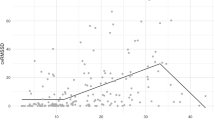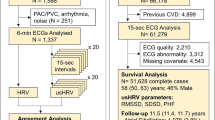Abstract
Background
In coronary artery disease (CAD) and following myocardial infarction (MI), activity of the autonomic nervous system is altered. Reduced heart rate variability (HRV) is a risk factor for future cardiac event. Studies reporting changes in HRV post-cardiac rehabilitation (CR) are heterogeneous, due possibly to varied data collection and analysis protocols.
Aim
To evaluate changes in spectral measures of HRV derived from 5-minute ECG recordings in patients completing an 8 weeks CR programme.
Methods
Thirty-eight patients (21 males, 17 females, aged 65.6 ± 11.6 years) underwent 5 minutes, supine ECG recordings and standard physiological and psychological assessment pre- and post-CR. A further 23 patients (14 males, 9 females aged 64.9 ± 9 years) acted as controls. Outcome measures were: low frequency power, (LF, 0.04–0.15 Hz) high frequency power (HF, 0.15–0.40 Hz), LF:HF ratio and mean RR interval. Change was assessed by ANCOVA and paired t-tests.
Results
When compared with the CT group, the CR group showed significant increases in: SDNN (Δ +6 ms, CR vs. 0 ms CT), HFln (Δ 0.4 log units CR vs. 0 log units CT), LFln (Δ +0.6 log units CR, vs. +0.1 log units CT) and RR interval (Δ +30 ms, CR vs. −28 ms CT).
Conclusions
This is the first study to show significant increases in raw LF and HF power derived from short-term ECG recordings in CR patients. These measures are risk factors for future cardiac event. As CR is associated with increases in these measures it may be viewed as an effective therapy capable of bringing about favourable alterations in autonomic control.
Similar content being viewed by others
References
Balanescu S, Corlan A, Dorobantu M, Gherasim L (2004) Prognostic value of heart rate variability after acute myocardial infaction. Med Sci Monit 10:CR307–CR315
Bigger JT Jr, Fleiss JL, Rolnitzky LM, Steinman RC, Schneider WJ (1991) Time course of recovery of heart period variability after myocardial infarction. J Am Coll Cardiol 18:1643–1649
Bigger JT, Fleiss JL, Rolnitzky LM, Steinman RC (1993) The ability of several short-term measures of RR variability to predict mortality after myocardial infarction. Circulation 88:927–934
Billman GE (2002) Aerobic exercise conditioning: a nonpharmacological antiarrhythmic intervention. J Appl Physiol 92:446–454
Booth S, Adams L (2001) The shuttle walking test: a reproducible method for evaluating the impact of shortness of breath on functional capacity in patients with advanced cancer. Thorax 56:146–150
Boulay P, Prud’homme D (2004) Health-care consumption and recurrent myocardial infarction after 1 year of conventional treatment versus short- and long-term cardiac rehabilitation. Prev Med 38:586–593
Carpeggiani C, Emdin M, Bonaguidi F, Landi P, Michelassi C, Trivella MG, Macerata A, L’Abbate A (2005) Personality traits and heart rate variability predict long-term cardiac mortality after myocardial infarction. Eur Heart J 26:1612–1617
Duru F, Candinas R, Dziekan G, Goebbels U, Myers J, Dubach P (2000) Effect of exercise training on heart rate variability in patients with new-onset left ventricular dysfunction after myocardial infarction. Am Heart J 140:157–161
Faber TS, Staunton A, Hnatkova K, Camm AJ, Malik M (1996) Stepwise strategy of using short- and long-term heart rate variability for risk stratification after myocardial infarction. Pacing Clin Electrophysiol 19:1845–1851
Fei L, Copie X, Malik M, Camm AJ (1996) Short- and long-term assessment of heart rate variability for risk stratification after acute myocardial infarction. Am J Cardiol 77:681–684
Iellamo F, Legramante JM, Massaro M, Raimondi G, Galante A (2000) Effects of a residential exercise training on baroreflex sensitivity and heart rate variability in patients with coronary artery disease: A randomized, controlled study. Circulation 102:2588–2592
Jurca R, Church TS, Morss GM, Jordan AN, Earnest CP (2004) Eight weeks of moderate-intensity exercise training increases heart rate variability in sedentary postmenopausal women. Am Heart J 147:e21
Kuch B, Hense HW, Sinnreich R, Kark JD, von Eckardstein A, Sapoznikov D, Bolte HD (2001) Determinants of short-period heart rate variability in the general population. Cardiology 95:131–138
La Rovere MT, Mortara A, Sandrone G, Lombardi F (1992) Autonomic nervous system adaptations to short-term exercise training. Chest 101:299S–303S
Lampert R, Ickovics JR, Viscoli CJ, Horwitz RI, Lee FA (2003) Effects of propranolol on recovery of heart rate variability following acute myocardial infarction and relation to outcome in the Beta-Blocker Heart Attack Trial. Am J Cardiol 91:137–142
Lanza GA, Guido V, Galeazzi MM, Mustilli M, Natali R, Ierardi C, Milici C, Burzotta F, Pasceri V, Tomassini F, Lupi A, Maseri A (1998) Prognostic role of heart rate variability in patients with a recent acute myocardial infarction. Am J Cardiol 82:1323–1328
Lanza GA, Galeazzi M, Guido V, Lucente M, Bellocci F, Zecchi P, Maseri A (1999) Additional predictive value of heart rate variability in high-risk patients surviving an acute myocardial infarction. Cardiologia 44:249–253
Leitch JW, Newling RP, Basta M, Inder K, Dear K, Fletcher PJ (1997) Randomized trial of a hospital-based exercise training program after acute myocardial infarction: cardiac autonomic effects. J Am Coll Cardiol 29:1263–1268
Lucini D, Milani RV, Costantino G, Lavie CJ, Porta A, Pagani M (2002) Effects of cardiac rehabilitation and exercise training on autonomic regulation in patients with coronary artery disease. Am Heart J 143:977–983
Malfatto G, Facchini M, Bragato R, Branzi G, Sala L, Leonetti G (1996) Short and long term effects of exercise training on the tonic autonomic modulation of heart rate variability after myocardial infarction. Eur Heart J 17:532–538
Malfatto G, Facchini M, Sala L, Branzi G, Bragato R, Leonetti G (1998) Effects of cardiac rehabilitation and beta-blocker therapy on heart rate variability after first acute myocardial infarction. Am J Cardiol 81:834–840
Malfatto G, Facchini M, Sala L, Branzi G, Bragato R, Leonetti G (2000) Relationship between baseline sympatho-vagal balance and the autonomic response to cardiac rehabilitation after a first uncomplicated myocardial infarction. Ital Heart J 1:26–232
Malfatto G, Branzi G, Gritti S, Sala L, Bragato R, Perego GB, Leonetti G, Facchini M (2001) Different baseline sympathovagal balance and cardiac autonomic responsiveness in ischemic and non-ischemic congestive heart failure. Eur J Heart Fail 3:197–202
Mazzuero G, Lanfranchi P, Colombo R, Giannuzzi P, Giordano A (1992) Long-term adaptation of 24-h heart rate variability after myocardial infarction. The EAMI Study Group. Exercise training in anterior myocardial infarction. Chest 101:304S–308S
Morris JN, Everitt MG, Pollard R, Chave SP, Semmence AM (1980) Vigorous exercise in leisure-time: protection against coronary heart disease. Lancet 2:1207–1210
Pardo Y, Merz CN, Velasquez I, Paul-Labrador M, Agarwala A, Peter CT (2000) Exercise conditioning and heart rate variability: evidence of a threshold effect. Clin Cardiol 23:615–620
Quintana M, Storck N, Lindblad LE, Lindvall K, Ericson M (1997) Heart rate variability as a means of assessing prognosis after acute myocardial infarction. A 3-year follow-up study. Eur Heart J 18:789–797
Reinhardt L, Makijarvi M, Fetsch T, Schulte G, Sierra G, Martinez-Rubio A, Montonen J, Katila T, Borggrefe M, Breithardt G (1996) Noninvasive risk modeling after myocardial infarction. Am J Cardiol 78:627–632
Takeyama J, Itoh H, Kato M, Koike A, Aoki K, Fu LT, Watanabe H, Nagayama M, Katagiri T (2000) Effects of physical training on the recovery of the autonomic nervous activity during exercise after coronary artery bypass grafting: effects of physical training after CABG. Jpn Circ J 64:809–813
Tarkiainen TH, Timonen KL, Tiittanen P, Hartikainen JE, Pekkanen J, Hoek G, Ibald-Mulli A, Vanninen EJ (2005) Stability over time of short-term heart rate variability. Clin Auton Res 15:394–399
Taskforce (1996) Heart rate variability: standards of measurement, physiological interpretation and clinical use. Task Force of the European Society of Cardiology and the North American Society of Pacing and Electrophysiology. Circulation. 93:1043–1065
Tygesen H, Wettervik C, Wennerblom B (2001) Intensive home-based exercise training in cardiac rehabilitation increases exercise capacity and heart rate variability. Int J Cardiol 79:175–182
Acknowledgements
The authors would like to thank Tracey Hughes and Jo Ganachaud for their help in data collection and running of the rehabilitation programme throughout the study.
Author information
Authors and Affiliations
Corresponding author
Rights and permissions
About this article
Cite this article
Sandercock, G.R.H., Grocott-Mason, R. & Brodie, D.A. Changes in short-term measures of heart rate variability after eight weeks of cardiac rehabilitation. Clin Auton Res 17, 39–45 (2007). https://doi.org/10.1007/s10286-007-0392-5
Received:
Accepted:
Published:
Issue Date:
DOI: https://doi.org/10.1007/s10286-007-0392-5




